DRIVEN BY THE HIGH DIVINE ORDER
|
|
|
|
Trinidadian of Indian Origin, Dennis Ramdahin, gave up the comfort of a plush New York office overlooking the Statue of Liberty to work in the fields of Bihar and Uttar Pradesh. He was answering a higher calling, and getting in touch with his ancestral land. The poverty alleviation project that he does is noble, and is inspirational. An interview with him
|
|
|
Please tell us about the Bihar Project of the Vihara Foundation…
The Bihar Project has recently changed its name to The Vihar Project to avoid any stigma that may arise through politics. Vihar in fact is a word from which Bihar derived, meaning place of monasteries, and is representative of the project's proposal to help all in the poverty afflicted region.
The Vihar Project is the first project of the Vihara Foundation. It is a macro-economic, macro-scale, integrated, sustainable development proposal being researched and concurrently implemented for uprooting poverty and fostering development in India's most poverty stricken and underdeveloped regions, comprising Bihar and Uttar Pradesh—also the ancestral home for many Indian Diasporas who were taken to places far off around the world.
Founded by myself, a Trinidad-born PIO scientist, this project is being moved from paper into action, and is exemplified as a way for Global Indo Diasporas to play a role to helping the present people of the region, and to pay tribute to the many forefathers that sacrificed, in India, and overseas, loaning up to who we are today. The bravery, fear, sweat, loneliness, cultural disconnect, motherly disconnect, are priceless attributes and contributions to protecting and securing the welfare of the future generations that would carry forward the genetics, culture and heritage to Indo-pride and righteousness.
To date, the Vihar Project has been internally funded (by myself and its project members), however, going forward, funding is necessitated to cover the cost and completion of research, capital upgrades of infrastructure, implementation of new technologies (irrigation and energy), and legal lobbying of marketing and creative financing policy instruments being designed to make the project expansion "self financing" and "self-sustainable".
Research and development action is currently underway in Ballia UP and Nalanda Bihar testing and implementing the model in the field. Built upon a three-prong approach of community cooperation, creative financing and eco-resource technology integration, the model aims to build unison amongst small farmers, merge farm holding into large cooperative holdings, model and assess the economic equity between base poverty situation and high optimized sustainable agricultural operations within the cooperative holdings, create sustainable financing instruments against this equity, and finance capital improvement of technology and infrasture needed for development under a risk management development arrangement.
Currently the model has brought small farmers together to trial 100 hectares, growing out to 500 hectare by this July 2011, and hopefully exscaling out to 50,000 hectares (100 villages) by July 2012 (contingent on funding), completing testing and policy institution for proofing the development model by June 2013, that would then be replicated to other regions for fighting poverty.
|
|
|
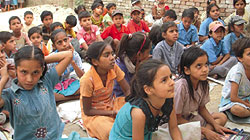
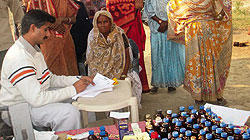
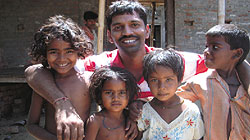
From top: Facilitating education to
children that would otherwise add to the statistics
of illiteracy. Children learn to read, write and
speak English and Hindi, Math, about the world
around them and hygiene and health.
A free clinic that has been set up for the villagers. Access to medical care amongst the poor is very difficult. Women are reluctant to discuss their ailments with the doctor.
Project coodinator Vinod Tiwari and the beautiful children of the project. When the children cry too he is there for them. Vinod coodinates the school and clinic. Vinod was instumental in building community unison for project outgrowth. |
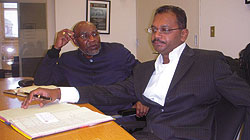
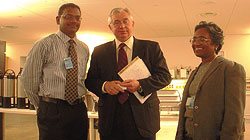
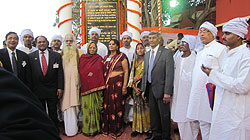
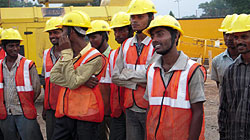
From top: Ambassador Byron Blake, former senior advisor to the President of the United Nations General Assembly, Chair of the G77 and China, and Chairman of the Vihara Foundation, and myself at Columbia University Earth Institute disucssing means forward for the project. Nov 2009.
United Nations Chief Section NGO, Andrei Abramov and myself, during my deliberations at the UN to discuss the Vihar Project. May 2010.
A group of men from Ballia in Uttar Pradesh wearing traditional white clothing seen at the Kolkata Memorial. Their ancestors made the voyage across the seas.
Migratory labourers in the Kolkata Metro project - sons of Bihar and UP farmers who have left their villages to earn livelihood. Avg salary 100 Rupees per day. |
|
|
|
Your vision is very noble, and appreciable. How does your Foundation plan to generate resources to reach its goals?
The foundations's ideals is not centered around money, and as proven over the last two years, and since 2003 since the will to do this work was inspired, much can be accomplished without external funding. As the project has evolved to build community strength needed to counter the ill forces keeping the farmers and region in poverty, there is a belief that where there is a will there is a way. We will just let God protect and guide us in this direction.
There are a number of channels through which the Foundation plans to generate
resouces. One definitely is thought engagement Diaspora stakeholders. We want the Diaspora community to find value in the work we are doing, and fell the need and compassion to help their ancestral relatives to achieve development and come out of poverty. If this will is not inbound within the Diaspora community, then there is no point knocking on this door, but there is a good feeling by the people of Bihar/Uttar
Pradesh, that their relative brothers and sisters will come forward.
Vihara Foundation will also depend on tapping into government and philantrophy grants and other development resources, but more important, VF is instituting and spawning its own creative fundraising movement, called Rock against Poverty. This is an art/film/music/fashion/sports momement to give the entertainment/sports industry and its vast fan based an opportunity to answer the call. It is built on the premise of one person putting one dollar per year towards the cause of poverty and climate change, which in global terms could grow into a substantial funding base to support good work all accross the world, including all Diaspora countries. But, we are far from there yet, the first launch of RaP taking place in
Kolkata, Dec 8 2010, and the next one planned for New York City, April 22 Earth Day, inconjunction with partnering NGO's and member states of the United Nations.
|
| |
|
I can recall myself hating sitting in a New York downtown office watching the statue of Liberty and saying, this experience is not rewarding and fulfilling. A sense of personal achievement has no true merit or human worth if it cannot be put to helping others |
| |
Why have you chosen the areas that you have for your work?
Truely, there was no preference of personal choice. by some higher supernatural order unexplainable, I was directed to Ballia from where the project found an entry point. Through this entry point is from where community trust was built, and the project saw a growth of initial seven farmers to now several thousand farmers (from one village, the project has built critical mass/following in a sphere of some 100 villages and growing. There is no telling how the project would have evolved when probing an entry point with little or no trust by the community, a theoretical proposal that is worthy on paper but unproven in application, and other factors and uncertainties. Fortunately, some critical factors worked to my advantage: the fact that I looked Indian and not foreign, my forefathers were from the region, I am a Diaspora willing to contribute something back to help the poor farmers, and sheer luck and output of personal body energy and charisma. Also, and most important, are the important people on the project that paved a way for change to be embraces, people like Vinod
Tiwari, Project Laision, and Vijay Sankar Tiwari, Project instigator and economist, Shashi Giri Kant, law advocate and project champion. In essence, some framework of development leadership took shape at the base village level.
Also, the mere fact of Ballia's unique historic and political richness loaned itself to the project. In less than six months on the ground, the project garnened the full support of prominent ex-member parliment
Ballia, Shri Bohla Misra, and now Neeraj Shekhar, son of former Indian Prime Minister Chandra
Shekhar. What more prominent place in all of India to start this project. The project would soon grow out an extention in Nalanda Bihar, under the leadership and guidance of Dr. Vikas Kumar, a scientist attached to Sheffield University in England.
What are the major challenges that you as a development practitioner have come across while working on your projects in eastern
U.P. and Bihar?
Some of the major challenges have been lack of funding. Lack of funding sets us back in countering negative market forces. As farmers pool their harvest to approach bulk markets, they are incapable of doing so as middlemen make it
inpenetrable. Futher, countering this problem from a legal, lobbying and policy standpoint is restricted by funding.
Funding shortages also has set back the data collection and its statistical analysis for establishing the prerequiste risk managment confidence limits for institution of creative financing. Nonetheless, we are entrusting that these are scheduled and driven by the High Divine Order, and will be achieved soon.
As a Trinidadian of Indian origin, what really excited you to come so far away from home and work in the interiors of India?
Well, there was no personal gain motives. I didnt know what was earmarked as my
desitiny. I just go with the flow.
The will to work in the area of poverty alleviation has always been ingrown...but very difficult to explain and express in physical terms. It was only during my first travel through the region in October 2003 (with my father) that I was privied to the graphic conditions confronting the people —a level and state of underdevelopment never yet exposed to or experienced. Further, during a stop in Dhanbad Station
Jharkhand, revealed in one of the photos taken there were a little boy and girl, their hands reaching out, as if there is a deeper calling for help in aid of the plight that is plaguing the people. This picture really would inspire to think outside the box to come up with ideas and strategies for addressing poverty. Picture is presently on our website.
Further explaining, the answer to this excellent question is not easily explainable, as I do not seem to have control over my faith and karma, and find myself committed to helping these people. Everyday I miss my son and family back in New York and Trinidad, but what can I do. This drive has to be from inside and compelling, as I can recall myself hating sitting in a New York downtown office watching the statue of Liberty and saying, this experience is not rewarding and fulfilling. A sense of personal achievement has no true merit or human worth if it cannot be put to helping others.
Once here, the drive to stay commited and work harder further manifests itself. This is the hallowed ground upon which my forefarthers were born, walked, ate and slept. I am a son of the soil, destined to pay servitude to this society and humanity. I see imprint of my beloved grandparents, everywhere around me, and if I turn my back on this project and people, I would do injustice to many the forefathers that is depending on me to work hard and deliver.
Though I despise the statement and comments (because the price of failure is high and dishonorable, and
inexcusible) the people of the project called me "the chosen one / the messenger from God." I despise these affiliation on the basis of, if it was indeed, I would be working harder for these people, more than I already do. The test to assume such noble title is also enduring, and tiring, and sometimes scary with a feeling of insecurity.
You are currently based in Kolkata, working on a section of the Metro Rail Project. What made you choose Kolkata as the port of call for your work?
Well, I am the Chief Safety Engineer for the entire metro rail project. I always though of Calcutta as the port of embarkation of the forefathers. I visited here in October 2003, and realized this is the only city I can comfortably work and live in. In a sense, this feels like home away from home, as I dont think I can live in any other Indian City. From here I can access Bihar, Uttar
Pradesh, Orissa and West Bengal where a lot of the Foundation work may be applicable.
Its also worth mentioning that I was born in Calcutta Settlement Village in Trinidad.
During the inauguration of the Kolkata Memorial on January 11, many people, including you, were dressed in all white traditional Indian wear. What was the significance of that?
We wanted to send a message to the world, from Ballia Uttar Pradesh and all of the region, that the forefathers left in a uniform color of white
Khadi, with togetherness and unity to survive and toil in their foreign lands. These were the uniform and colors which they climbed on the ships, and which they got down, toiled in, and which they died in their foreign homes. Dressing in all white in traditional Indian wear was a way to highlight the participation of the forefathers at the ceremony, and pay respect to their servitude...they are not forgotten and never will be.
Furthermore, the indentured forefathers, if they could evoke a message of appreciation and gratiude for this setting up of this memorial in recognition of their sacrifice, and preservation and rightful positioning of Indian Indentured history, they would confer this to Leela Sarup .
Truely, all Diasporas globally should be thankful to Leela for her pioneering and instrumental role in proposing the idea to Govt of India and following through to make this (memorial) a reality - she (the memorial), in the sunrise and sunset overlooking the
Hoogly, stands as a beacon to the rest of the Diaspora world, a navel string bond permanently reconnected back to the Mother, and which invites all Diasporas to pay interest in the ancestral lands.
—For further information please contact Dennis@Viharafoundation.org
|
|
|
|
April 2011
|
|


|
|
|
|